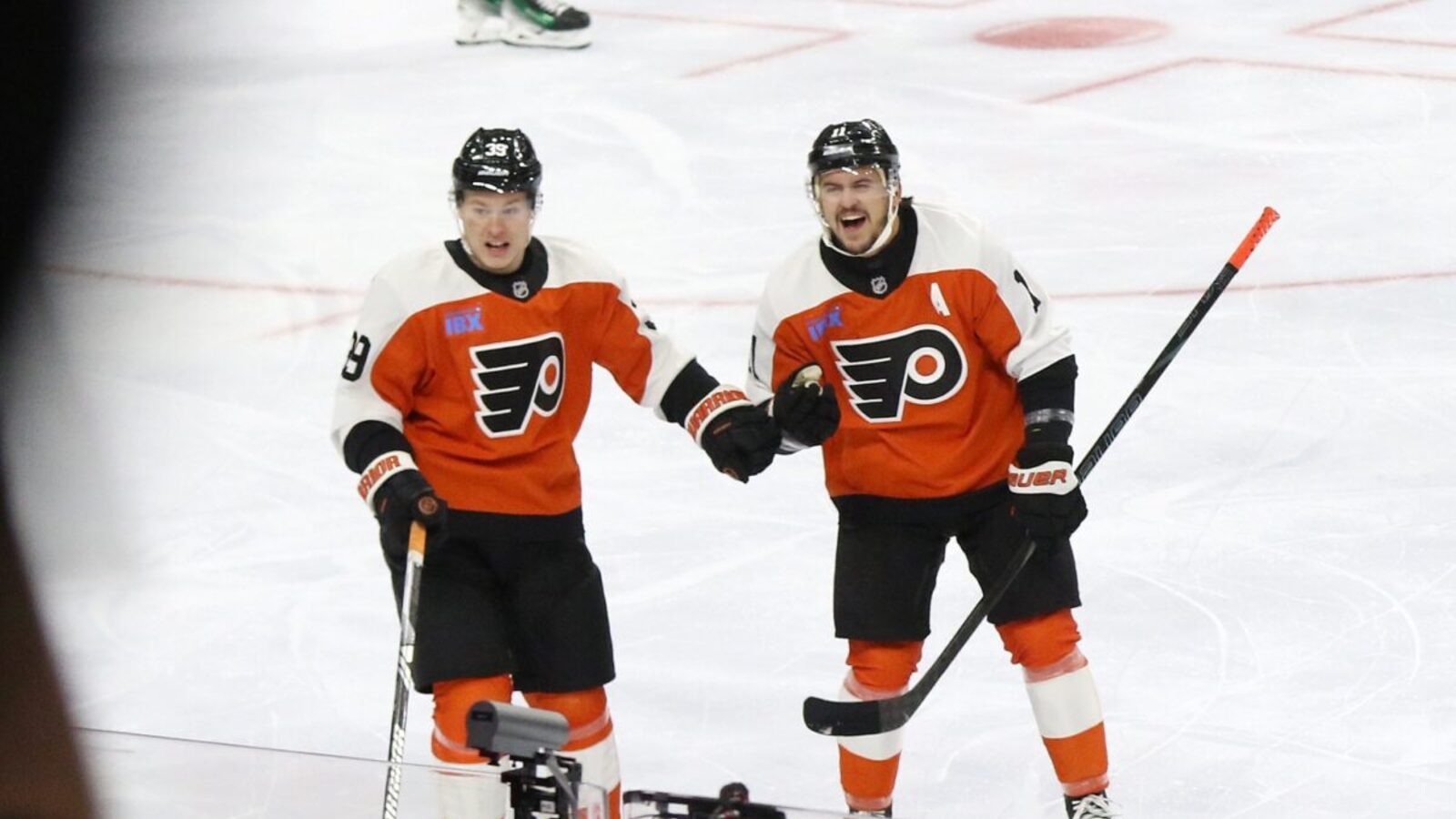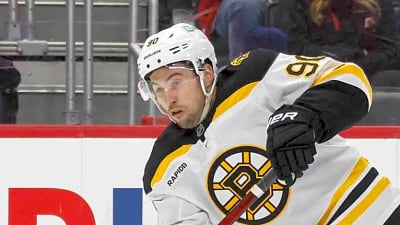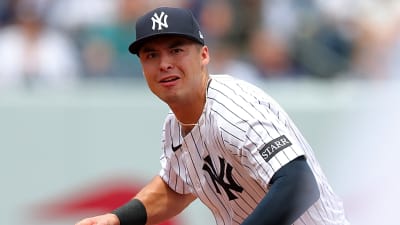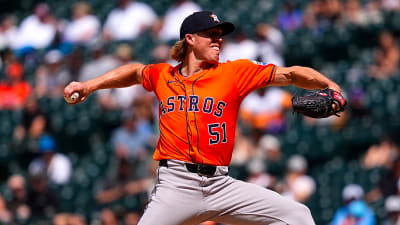
The Philadelphia Flyers may still have some tasks to complete this offseason, but the bulk of their work is done. Following a highly acclaimed 2025 draft class and an unexpected free-agent expenditure (if you can call it that), let’s project the team’s opening roster for 2025–26.
Projecting the Flyers’ Forward Lines
I’ll start with the forwards. You might notice that Tyson Foerster isn’t here, but an infection in his elbow could sideline him for a while. The timeframe is unknown, according to general manager Daniel Brière, but the roster below assumes that the injury extends through opening night. With that in mind, here’s the offense:
| Left Wing | Center | Right Wing |
| Travis Konecny | Trevor Zegras | Matvei Michkov |
| Porter Martone | Sean Couturier | Owen Tippett |
| Alex Bump | Jett Luchanko | Bobby Brink |
| Christian Dvorak | Noah Cates | Garnet Hathaway |
| Nicolas Deslauriers |
On the top line, the Travis Konecny and Matvei Michkov duo from the end of last season is being reunited. The two worked magic together, averaging 3.58 goals per 60 minutes of 5-on-5 play—a rate that bested Auston Matthews and Mitch Marner (3.44), to give an example. While defensive woes should be expected, this high-octane combination can certainly light the lamp, which is something the Flyers have struggled to do since 2021–22 (haven’t finished outside the bottom 10 in goals scored).

The only difference here is having Trevor Zegras down the middle. An elite puck carrier with immense creativity, playmaking ability, and 1-on-1 prowess, he adds an essential dynamic to this line. Going all-in on scoring may not be head coach Rick Tocchet’s style, but if he wants offense, he’s sure to get it with this trio. For some more well-rounded play, Noah Cates is an option on the left wing (suggested by Daily Faceoff’s Anthony Di Marco).
The second line can also provide a scoring touch. Porter Martone is one of the most NHL-ready prospects from his 2025 draft class, poised to compete for a spot on the opening night roster. He can provide the vision, shot, and forechecking to maximize the scoring output of Owen Tippett and Sean Couturier. It may take time for Martone to showcase these high-end traits consistently, but the talent and upside are undeniable.
Let’s lean on a couple of rookies for the third line. Even the Flyers’ brand-new coaching staff should fall in love with Jett Luchanko’s game—extremely fast, two-way, and playmaking. Though he’s still 18 years old, he offers immediate promise to the NHL lineup. With not much else to learn at the junior level and the only other option being to join the Flyers, the front office may see this as the best fit, too.
He can complement Alex Bump, who established some chemistry with Luchanko in the American Hockey League (AHL) during the spring. Bump, 21 years old, was the top player on Western Michigan University’s championship-winning squad. With shooting talent and play-driving ability, he can turn some heads at training camp and potentially earn a spot on the full-time roster despite his youth. Rounding everything out is Bobby Brink, who can be a complementary piece to the puzzle—a good shot, playmaking, and two-way effort.
The fourth line can be used in shutdown situations. That’s a role Cates and Garnet Hathaway have embraced over the past couple of seasons and will likely continue to. Christian Dvorak was used regularly on the Montreal Canadiens’ penalty kill and allowed goals at a 14.11% lower rate than the team did without him in 2024–25, so he’s probably best suited with this duo. Though maybe not elite on paper, this forward group could be fun.
Projecting the Flyers’ Defensive Pairings
Like Foerster, I’m assuming Rasmus Ristolainen will miss out on the opening night lineup following surgery in late March. His expected six-month recovery period should have him slated to return for Game 1, but the Flyers may be conservative. If they are, here’s what the defense might look like:
| Left Defense | Right Defense |
| Cam York | Travis Sanheim |
| Nick Seeler | Jamie Drysdale |
| Emil Andrae | Noah Juulsen |
| Dennis Gilbert | Egor Zamula |
Though they’ve played their best hockey away from one another, I’m making Cam York and Travis Sanheim the top pairing because it’s still the most likely. Previously, this was a duo capable of eating big minutes at 5-on-5 and performing well on the expected goal front, but falling short in actual results (41.92% goal share since 2023–24). Under a new coaching staff, however, things might change.
“Restricted” is perhaps the best word to describe York over the past couple of seasons—even he’ll tell you that (from ‘Flyers exit interviews: Sean Couturier felt ‘pushed aside’ by John Tortorella; Cam York excited to play ‘freer’,’ The Philadelphia Inquirer – April 18, 2025). If the 24-year-old has any untapped potential, it’ll show in 2025–26.
The second pairing is another familiar one. Nick Seeler and Jamie Drysdale played best following the latter’s return from a month-long injury on Dec. 8, but their full-season numbers at 5-on-5 were quite good, too: a 54.72% goal share and 51.24% expected goal share across 588 minutes. Considering Drysdale was outscored 21–5 at five-a-side action in his debut campaign with the Orange and Black, the 23-year-old’s growth is inspiring. He’s expected to take another step under Tocchet.
With Dennis Gilbert and Egor Zamula sure to compete for the Flyers’ left-side role on the third pairing, Emil Andrae’s work is cut out for him—he’s young (23) and undersized (5-foot-9, 189 pounds). However, he was the most positively impactful defenseman of the bunch in 2024–25. Plus, Noah Juulsen’s heavy-hitting style could provide a nice balance. Don’t expect immediate consistency on the bottom pair, but an Andrae-Juulsen combination could be effective.
It’s a lot to ask out of Sanheim, who signed for No. 3 defenseman money entering the 2022–23 season, to eat the minutes he does (fifth-most in the NHL since 2023–24; regular season only). But aside from the top-pairing debacle, the Flyers have decent depth on the back end, with both puck-moving ability and physicality throughout.
Projecting the Flyers’ Goaltenders
Now, for the goaltending. Evolving-Hockey has been tracking data since 2007–08, or nearly two decades. Across 552 entries in that span, no team has put up a worse single-season save percentage than the 2024–25 Flyers (.873). With a new face in the mix, are they destined to improve?
| Goaltenders |
| Samuel Ersson |
| Dan Vladař |
There are two things working in the Flyers’ favor. One is the fact that John Tortorella and his staff are no longer behind the bench—you can’t put up the worst team save percentage of the analytics era without any responsibility falling on the coaches. The second is that, while Dan Vladař may not boast spectacular numbers (.895 career save percentage), he has a track record as a backup in the NHL, unlike 2024–25 rookies Ivan Fedotov and Aleksei Kolosov. A consistent backup could go a long way.
The Flyers’ goaltending environment should be more stable in this upcoming campaign. Samuel Ersson has shown flashes as a starter, at the very least, so there’s always hope that he can be serviceable on that front. If he is, and Vladař follows suit, that’s an unimaginable boost. Even “below average” would be a step in the right direction.
Brière was probably right when he said firing Tortorella was “rock bottom.” Preventing the longest postseason drought in franchise history is ultimately the goal (six seasons; currently tied with five), but this team should be semi-competitive in the Eastern Conference. Reaching the 35-win mark is a reasonable expectation.
Stats courtesy of Natural Stat Trick, unless specified otherwise
More must-reads:
- Three NHL teams that have missed the mark so far this offseason
- Three NHL teams that are having the best offseason so far
- The 'First-overall NHL Draft picks' quiz
Breaking News
Trending News
Customize Your Newsletter
 +
+
Get the latest news and rumors, customized to your favorite sports and teams. Emailed daily. Always free!








